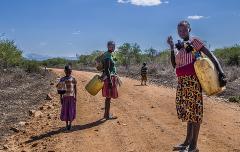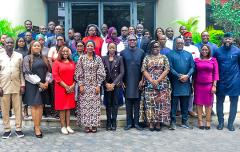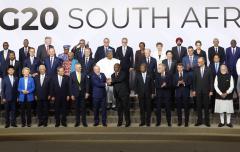Strong Policy Framework Needed for Solar Power
Many developing countries with sun-baked deserts are investing in concentrated solar power, or CSP. While the climatic conditions are right for the technology, these countries face challenges in making CSP viable. These include financing and risk mitigation, reducing costs, and building local capacity, among others.
A group of energy policymakers and practitioners from Morocco, Egypt, South Africa and India, as well as officials from financial institutions and European donor agencies, gathered in Marrakesh, Morocco in October 2013 to share experiences on how they manage their utility-scale solar programs.
The South-South Knowledge Exchange Workshop, Strengthening the Solar Energy Option and Utility-Scale Solar Power Development & Management, was co-organized by the Moroccan Agency for Solar Energy (MASEN) and the World Bank under the aegis of the Sustainable Energy for All (SEforALL) Initiative. The workshop was also supported by the World Bank Institute and the Energy Sector Management Assistance Program (ESMAP).
The two-day workshop, hosted by Mustapha Bakkoury, CEO of MASEN, and also a member of SEforALL’s Advisory Board, addressed these questions:
 Participants agreed that tendering and reverse auctions are becoming the preferred option to procure CSP plants, as well as determine the appropriate level of price incentives. But these incentives, they said, cannot operate in a vacuum; the regulatory framework should remove barriers and provide an enabling environment to ensure that the incentives work.
Balancing domestic manufacturing with solar deployment
Many speakers noted that countries often impose local content requirements on solar project developers. Sometimes this practice compromises access to concessional financing, or conflicts with WTO agreements. Many countries do it nonetheless, as creating jobs is often an important goal in launching solar programs, along with industrial development. Participants—while acknowledging that job creation is desirable—also largely agreed that countries need to make strategic choices as to the type of local content they seek. Countries need to look at the supply chain as a whole, and identify areas in which they can develop a competitive advantage, at least at regional or local levels. Speakers from Morocco, India and Germany explained how their countries focused on specific elements of the CSP value chain to remain competitive; all agreed that competitiveness must be established and sustained to bring down solar energy prices paid by the consumer.
Large-scale integration of solar power into grids
Utility-scale solar aims to integrate CSP into power grids. But this poses challenges, depending on the state of a country’s transmission and distribution network, its energy demand, energy mix and share of flexible generation, as well as the type of preferred solar technology and location of the resource. Finally, interconnections within the regions of the country and with neighboring countries must also be taken into account.
For Morocco, CSP integration seeks to enhance energy security. Power can be dispatched to meet evening peak demand. The facility is designed, ultimately, to export power to green premium markets in Europe.
For India, however, the priority is to respond to soaring demand for electricity. Implementation of the first phase of India’s national solar program has shown that photo-voltaic (PV) is likely to become the prevalent solar technology in India; its cost is low cost and it can be developed quickly. This has prompted the government to establish measures to enhance integration, including transmission interconnection, new inverters, and smart-grid applications to enhance the performance of distributed solar mini-grids, independent of the main grid.
CSP (with storage) is more expensive than PV, but it has advantages from a grid-integration point of view. Large-scale integration of PV power plants requires large investments in the transmission and distribution and back-up capacity, the workshop was told.
Pre-requisites for development of large scale solar projects
Lack of local capacity is a persistent barrier to solar project development. Educational programs are needed to build the local capacity needed to ensure success. In addition, consultation and involvement of all stakeholders, including civil society, is important, as is the permit-awarding process, which must sensitively take land rights into account. For example, in India, following the disclosure of resource mapping results the value of land in some areas has grown fivefold. This has the potential to set off land speculation, undermine the development of solar projects and needs to be managed carefully to ensure the viability of the projects as well as benefits for the local people.
Participants agreed that tendering and reverse auctions are becoming the preferred option to procure CSP plants, as well as determine the appropriate level of price incentives. But these incentives, they said, cannot operate in a vacuum; the regulatory framework should remove barriers and provide an enabling environment to ensure that the incentives work.
Balancing domestic manufacturing with solar deployment
Many speakers noted that countries often impose local content requirements on solar project developers. Sometimes this practice compromises access to concessional financing, or conflicts with WTO agreements. Many countries do it nonetheless, as creating jobs is often an important goal in launching solar programs, along with industrial development. Participants—while acknowledging that job creation is desirable—also largely agreed that countries need to make strategic choices as to the type of local content they seek. Countries need to look at the supply chain as a whole, and identify areas in which they can develop a competitive advantage, at least at regional or local levels. Speakers from Morocco, India and Germany explained how their countries focused on specific elements of the CSP value chain to remain competitive; all agreed that competitiveness must be established and sustained to bring down solar energy prices paid by the consumer.
Large-scale integration of solar power into grids
Utility-scale solar aims to integrate CSP into power grids. But this poses challenges, depending on the state of a country’s transmission and distribution network, its energy demand, energy mix and share of flexible generation, as well as the type of preferred solar technology and location of the resource. Finally, interconnections within the regions of the country and with neighboring countries must also be taken into account.
For Morocco, CSP integration seeks to enhance energy security. Power can be dispatched to meet evening peak demand. The facility is designed, ultimately, to export power to green premium markets in Europe.
For India, however, the priority is to respond to soaring demand for electricity. Implementation of the first phase of India’s national solar program has shown that photo-voltaic (PV) is likely to become the prevalent solar technology in India; its cost is low cost and it can be developed quickly. This has prompted the government to establish measures to enhance integration, including transmission interconnection, new inverters, and smart-grid applications to enhance the performance of distributed solar mini-grids, independent of the main grid.
CSP (with storage) is more expensive than PV, but it has advantages from a grid-integration point of view. Large-scale integration of PV power plants requires large investments in the transmission and distribution and back-up capacity, the workshop was told.
Pre-requisites for development of large scale solar projects
Lack of local capacity is a persistent barrier to solar project development. Educational programs are needed to build the local capacity needed to ensure success. In addition, consultation and involvement of all stakeholders, including civil society, is important, as is the permit-awarding process, which must sensitively take land rights into account. For example, in India, following the disclosure of resource mapping results the value of land in some areas has grown fivefold. This has the potential to set off land speculation, undermine the development of solar projects and needs to be managed carefully to ensure the viability of the projects as well as benefits for the local people.
 Financing and risk management instruments
Most CSP projects use concessional finance which can’t be sustained in the future. A key concern, therefore, is the need to reduce the cost of solar energy, to put it on a market basis. In South Africa, the workshop was told, a structured finance approach is being applied to projects to provide a bridge from concessional to commercial finance. South African commercial banks are providing finance to large renewable energy projects, but a new concern has arisen as these banks are over-exposed. They are consequently unwilling to invest further.
Risk mitigation products could provide an alternative to concessional loans, and leverage private financing. Public Private Partnerships could also be used to make projects bankable.
“This workshop gave us a unique opportunity to share our experience and also learn from other countries’ experiences, and thus to deepen our knowledge of the latest developments in large-scale solar projects,” said Nonhlanhla Ngwenya, solar park program manager for South Africa’s CEF (SOC) Ltd.
Given the positive reception that greeted the workshop, the World Bank and Sustainable Energy for All Initiative plan to host future workshops focused on specialized operational, technical and financial aspects of large-scale solar projects, including technology risks and feasibility of innovative financial instruments.
Financing and risk management instruments
Most CSP projects use concessional finance which can’t be sustained in the future. A key concern, therefore, is the need to reduce the cost of solar energy, to put it on a market basis. In South Africa, the workshop was told, a structured finance approach is being applied to projects to provide a bridge from concessional to commercial finance. South African commercial banks are providing finance to large renewable energy projects, but a new concern has arisen as these banks are over-exposed. They are consequently unwilling to invest further.
Risk mitigation products could provide an alternative to concessional loans, and leverage private financing. Public Private Partnerships could also be used to make projects bankable.
“This workshop gave us a unique opportunity to share our experience and also learn from other countries’ experiences, and thus to deepen our knowledge of the latest developments in large-scale solar projects,” said Nonhlanhla Ngwenya, solar park program manager for South Africa’s CEF (SOC) Ltd.
Given the positive reception that greeted the workshop, the World Bank and Sustainable Energy for All Initiative plan to host future workshops focused on specialized operational, technical and financial aspects of large-scale solar projects, including technology risks and feasibility of innovative financial instruments.
- What is the right policy and regulatory framework for utility-scale solar power?
- How to balance domestic manufacturing with deployment of different solar technologies? What are the challenges and opportunities?
- How to integrate solar power into power systems?
- What are the optimal pre-requisites for development of large scale solar projects?
- How to structure appropriate financing and risk management instruments under various development schemes?
 Participants agreed that tendering and reverse auctions are becoming the preferred option to procure CSP plants, as well as determine the appropriate level of price incentives. But these incentives, they said, cannot operate in a vacuum; the regulatory framework should remove barriers and provide an enabling environment to ensure that the incentives work.
Balancing domestic manufacturing with solar deployment
Many speakers noted that countries often impose local content requirements on solar project developers. Sometimes this practice compromises access to concessional financing, or conflicts with WTO agreements. Many countries do it nonetheless, as creating jobs is often an important goal in launching solar programs, along with industrial development. Participants—while acknowledging that job creation is desirable—also largely agreed that countries need to make strategic choices as to the type of local content they seek. Countries need to look at the supply chain as a whole, and identify areas in which they can develop a competitive advantage, at least at regional or local levels. Speakers from Morocco, India and Germany explained how their countries focused on specific elements of the CSP value chain to remain competitive; all agreed that competitiveness must be established and sustained to bring down solar energy prices paid by the consumer.
Large-scale integration of solar power into grids
Utility-scale solar aims to integrate CSP into power grids. But this poses challenges, depending on the state of a country’s transmission and distribution network, its energy demand, energy mix and share of flexible generation, as well as the type of preferred solar technology and location of the resource. Finally, interconnections within the regions of the country and with neighboring countries must also be taken into account.
For Morocco, CSP integration seeks to enhance energy security. Power can be dispatched to meet evening peak demand. The facility is designed, ultimately, to export power to green premium markets in Europe.
For India, however, the priority is to respond to soaring demand for electricity. Implementation of the first phase of India’s national solar program has shown that photo-voltaic (PV) is likely to become the prevalent solar technology in India; its cost is low cost and it can be developed quickly. This has prompted the government to establish measures to enhance integration, including transmission interconnection, new inverters, and smart-grid applications to enhance the performance of distributed solar mini-grids, independent of the main grid.
CSP (with storage) is more expensive than PV, but it has advantages from a grid-integration point of view. Large-scale integration of PV power plants requires large investments in the transmission and distribution and back-up capacity, the workshop was told.
Pre-requisites for development of large scale solar projects
Lack of local capacity is a persistent barrier to solar project development. Educational programs are needed to build the local capacity needed to ensure success. In addition, consultation and involvement of all stakeholders, including civil society, is important, as is the permit-awarding process, which must sensitively take land rights into account. For example, in India, following the disclosure of resource mapping results the value of land in some areas has grown fivefold. This has the potential to set off land speculation, undermine the development of solar projects and needs to be managed carefully to ensure the viability of the projects as well as benefits for the local people.
Participants agreed that tendering and reverse auctions are becoming the preferred option to procure CSP plants, as well as determine the appropriate level of price incentives. But these incentives, they said, cannot operate in a vacuum; the regulatory framework should remove barriers and provide an enabling environment to ensure that the incentives work.
Balancing domestic manufacturing with solar deployment
Many speakers noted that countries often impose local content requirements on solar project developers. Sometimes this practice compromises access to concessional financing, or conflicts with WTO agreements. Many countries do it nonetheless, as creating jobs is often an important goal in launching solar programs, along with industrial development. Participants—while acknowledging that job creation is desirable—also largely agreed that countries need to make strategic choices as to the type of local content they seek. Countries need to look at the supply chain as a whole, and identify areas in which they can develop a competitive advantage, at least at regional or local levels. Speakers from Morocco, India and Germany explained how their countries focused on specific elements of the CSP value chain to remain competitive; all agreed that competitiveness must be established and sustained to bring down solar energy prices paid by the consumer.
Large-scale integration of solar power into grids
Utility-scale solar aims to integrate CSP into power grids. But this poses challenges, depending on the state of a country’s transmission and distribution network, its energy demand, energy mix and share of flexible generation, as well as the type of preferred solar technology and location of the resource. Finally, interconnections within the regions of the country and with neighboring countries must also be taken into account.
For Morocco, CSP integration seeks to enhance energy security. Power can be dispatched to meet evening peak demand. The facility is designed, ultimately, to export power to green premium markets in Europe.
For India, however, the priority is to respond to soaring demand for electricity. Implementation of the first phase of India’s national solar program has shown that photo-voltaic (PV) is likely to become the prevalent solar technology in India; its cost is low cost and it can be developed quickly. This has prompted the government to establish measures to enhance integration, including transmission interconnection, new inverters, and smart-grid applications to enhance the performance of distributed solar mini-grids, independent of the main grid.
CSP (with storage) is more expensive than PV, but it has advantages from a grid-integration point of view. Large-scale integration of PV power plants requires large investments in the transmission and distribution and back-up capacity, the workshop was told.
Pre-requisites for development of large scale solar projects
Lack of local capacity is a persistent barrier to solar project development. Educational programs are needed to build the local capacity needed to ensure success. In addition, consultation and involvement of all stakeholders, including civil society, is important, as is the permit-awarding process, which must sensitively take land rights into account. For example, in India, following the disclosure of resource mapping results the value of land in some areas has grown fivefold. This has the potential to set off land speculation, undermine the development of solar projects and needs to be managed carefully to ensure the viability of the projects as well as benefits for the local people.
 Financing and risk management instruments
Most CSP projects use concessional finance which can’t be sustained in the future. A key concern, therefore, is the need to reduce the cost of solar energy, to put it on a market basis. In South Africa, the workshop was told, a structured finance approach is being applied to projects to provide a bridge from concessional to commercial finance. South African commercial banks are providing finance to large renewable energy projects, but a new concern has arisen as these banks are over-exposed. They are consequently unwilling to invest further.
Risk mitigation products could provide an alternative to concessional loans, and leverage private financing. Public Private Partnerships could also be used to make projects bankable.
“This workshop gave us a unique opportunity to share our experience and also learn from other countries’ experiences, and thus to deepen our knowledge of the latest developments in large-scale solar projects,” said Nonhlanhla Ngwenya, solar park program manager for South Africa’s CEF (SOC) Ltd.
Given the positive reception that greeted the workshop, the World Bank and Sustainable Energy for All Initiative plan to host future workshops focused on specialized operational, technical and financial aspects of large-scale solar projects, including technology risks and feasibility of innovative financial instruments.
Financing and risk management instruments
Most CSP projects use concessional finance which can’t be sustained in the future. A key concern, therefore, is the need to reduce the cost of solar energy, to put it on a market basis. In South Africa, the workshop was told, a structured finance approach is being applied to projects to provide a bridge from concessional to commercial finance. South African commercial banks are providing finance to large renewable energy projects, but a new concern has arisen as these banks are over-exposed. They are consequently unwilling to invest further.
Risk mitigation products could provide an alternative to concessional loans, and leverage private financing. Public Private Partnerships could also be used to make projects bankable.
“This workshop gave us a unique opportunity to share our experience and also learn from other countries’ experiences, and thus to deepen our knowledge of the latest developments in large-scale solar projects,” said Nonhlanhla Ngwenya, solar park program manager for South Africa’s CEF (SOC) Ltd.
Given the positive reception that greeted the workshop, the World Bank and Sustainable Energy for All Initiative plan to host future workshops focused on specialized operational, technical and financial aspects of large-scale solar projects, including technology risks and feasibility of innovative financial instruments.



